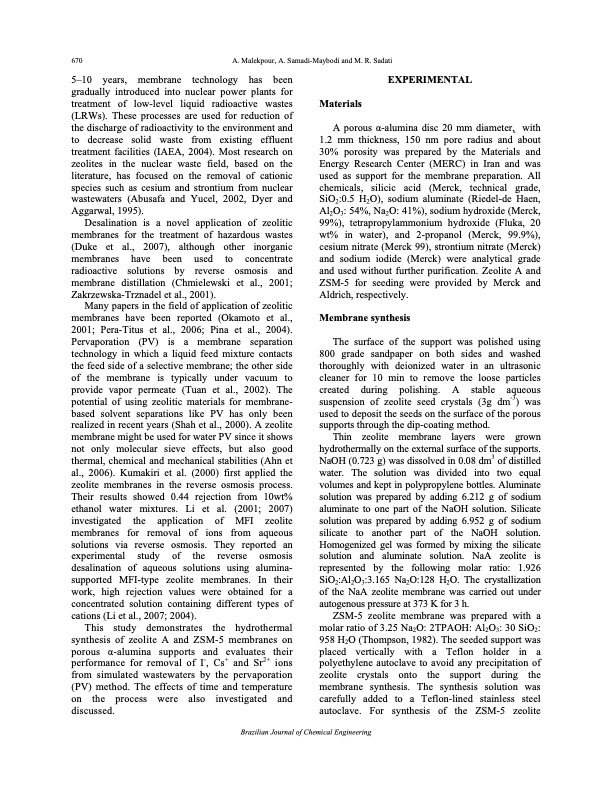
PDF Publication Title:
Text from PDF Page: 002
670 A. Malekpour, A. Samadi-Maybodi and M. R. Sadati 5–10 years, membrane technology has been gradually introduced into nuclear power plants for treatment of low-level liquid radioactive wastes (LRWs). These processes are used for reduction of the discharge of radioactivity to the environment and to decrease solid waste from existing effluent treatment facilities (IAEA, 2004). Most research on zeolites in the nuclear waste field, based on the literature, has focused on the removal of cationic species such as cesium and strontium from nuclear wastewaters (Abusafa and Yucel, 2002, Dyer and Aggarwal, 1995). Desalination is a novel application of zeolitic membranes for the treatment of hazardous wastes (Duke et al., 2007), although other inorganic membranes have been used to concentrate radioactive solutions by reverse osmosis and membrane distillation (Chmielewski et al., 2001; Zakrzewska-Trznadel et al., 2001). Many papers in the field of application of zeolitic membranes have been reported (Okamoto et al., 2001; Pera-Titus et al., 2006; Pina et al., 2004). Pervaporation (PV) is a membrane separation technology in which a liquid feed mixture contacts the feed side of a selective membrane; the other side of the membrane is typically under vacuum to provide vapor permeate (Tuan et al., 2002). The potential of using zeolitic materials for membrane- based solvent separations like PV has only been realized in recent years (Shah et al., 2000). A zeolite membrane might be used for water PV since it shows not only molecular sieve effects, but also good thermal, chemical and mechanical stabilities (Ahn et al., 2006). Kumakiri et al. (2000) first applied the zeolite membranes in the reverse osmosis process. Their results showed 0.44 rejection from 10wt% ethanol water mixtures. Li et al. (2001; 2007) investigated the application of MFI zeolite membranes for removal of ions from aqueous solutions via reverse osmosis. They reported an experimental study of the reverse osmosis desalination of aqueous solutions using alumina- supported MFI-type zeolite membranes. In their work, high rejection values were obtained for a concentrated solution containing different types of cations (Li et al., 2007; 2004). This study demonstrates the hydrothermal synthesis of zeolite A and ZSM-5 membranes on porous α-alumina supports and evaluates their performance for removal of I-, Cs+ and Sr2+ ions from simulated wastewaters by the pervaporation (PV) method. The effects of time and temperature on the process were also investigated and discussed. EXPERIMENTAL Brazilian Journal of Chemical Engineering Materials A porous α-alumina disc 20 mm diameter, with 1.2 mm thickness, 150 nm pore radius and about 30% porosity was prepared by the Materials and Energy Research Center (MERC) in Iran and was used as support for the membrane preparation. All chemicals, silicic acid (Merck, technical grade, SiO2:0.5 H2O), sodium aluminate (Riedel-de Haen, Al2O3: 54%, Na2O: 41%), sodium hydroxide (Merck, 99%), tetrapropylammonium hydroxide (Fluka, 20 wt% in water), and 2-propanol (Merck, 99.9%), cesium nitrate (Merck 99), strontium nitrate (Merck) and sodium iodide (Merck) were analytical grade and used without further purification. Zeolite A and ZSM-5 for seeding were provided by Merck and Aldrich, respectively. Membrane synthesis The surface of the support was polished using 800 grade sandpaper on both sides and washed thoroughly with deionized water in an ultrasonic cleaner for 10 min to remove the loose particles created during polishing. A stable aqueous suspension of zeolite seed crystals (3g dm-3) was used to deposit the seeds on the surface of the porous supports through the dip-coating method. Thin zeolite membrane layers were grown hydrothermally on the external surface of the supports. NaOH (0.723 g) was dissolved in 0.08 dm3 of distilled water. The solution was divided into two equal volumes and kept in polypropylene bottles. Aluminate solution was prepared by adding 6.212 g of sodium aluminate to one part of the NaOH solution. Silicate solution was prepared by adding 6.952 g of sodium silicate to another part of the NaOH solution. Homogenized gel was formed by mixing the silicate solution and aluminate solution. NaA zeolite is represented by the following molar ratio: 1.926 SiO2:Al2O3:3.165 Na2O:128 H2O. The crystallization of the NaA zeolite membrane was carried out under autogenous pressure at 373 K for 3 h. ZSM-5 zeolite membrane was prepared with a molar ratio of 3.25 Na2O: 2TPAOH: Al2O3: 30 SiO2: 958 H2O (Thompson, 1982). The seeded support was placed vertically with a Teflon holder in a polyethylene autoclave to avoid any precipitation of zeolite crystals onto the support during the membrane synthesis. The synthesis solution was carefully added to a Teflon-lined stainless steel autoclave. For synthesis of the ZSM-5 zeolitePDF Image | DESALINATION OF AQUEOUS SOLUTIONS ZEOLITE MEMBRANES

PDF Search Title:
DESALINATION OF AQUEOUS SOLUTIONS ZEOLITE MEMBRANESOriginal File Name Searched:
PCZPTXXvZ6pQgGbDbcz9VXd.pdfDIY PDF Search: Google It | Yahoo | Bing
CO2 Organic Rankine Cycle Experimenter Platform The supercritical CO2 phase change system is both a heat pump and organic rankine cycle which can be used for those purposes and as a supercritical extractor for advanced subcritical and supercritical extraction technology. Uses include producing nanoparticles, precious metal CO2 extraction, lithium battery recycling, and other applications... More Info
Heat Pumps CO2 ORC Heat Pump System Platform More Info
| CONTACT TEL: 608-238-6001 Email: greg@infinityturbine.com | RSS | AMP |